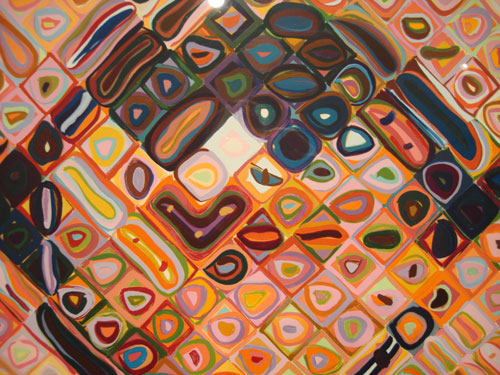
I'm thinking this needs to be done in stages.
1. He first creates a grid and fills each section with an arbitrary color.
I began by creating a mosaic. I used Opponent Random Flip for the Paint Color Source. My Brush Source is a Rect computational brush. My Path Start uses Grid Scan - MaxBrush to generate the grid based on the brush size.
2. He then adds an organic shape within each square. And adds another, smaller shape on top of that.

What he's doing is using 3 or 4 colors in each square to create an optical mix. Is there a way for StudioArtist to calculate the different hues (based on the underlying colors) which would create an optical mix equal to the source image?
I've bookmarked some posts here but the techniques don't address the optical color mixing
https://studioartist.ning.com/forum/topics/help-anyone-know-how-this-was
I assume I need to adjust settings in Paint Color Source, Paint Color Modulate, etc. but I can't figure it out after a lot of trial and error.
Here's what I have so far. Ignore the fact that the grid isn't diagonal and the concentric paint dabs aren't organic. I'll try to figure that out next.
Replies
You could also build a color palette or color gradient based on the local source coloring as a part of a MSG Brush Load, so then you could have a MSG preset that renders based on the color palette or color gradient.
I thought we addressed some of this before here at some point.
link
link
link
I'll put something together that uses some of the new vector paint features in studio artist 4 along with path start regionization to generate the regions. And that explores some of the approaches i mention above to get the multi-coloring for the optical mix going. That will get you closer to the micro-structure of the hand painted grid areas. It might take me a day or 2 to get around to doing it.
So you could take that approach, but try different modifications to get the look of the grid fill you want. Some things to try might be randomizing the source brush to get a more irregular hand drawn look, if you go that route. An alternative would be to figure out how to use region fill as brush pen mode to fill in the grid shapes with a concentric vector shape that gets smaller with repeated passes. In either case, you'd appropriately modulate the paint coloring for the concentric reduced size fills to get the optical mixing offsets you want.
However if you mean that you want paint strokes. Then truly you are going to want to use Bezier paths and the paint path abilities of SA. I suggest that you settle on your method of partitioning the canvas. try a block abstraction with a diamond nonstandard variation, for example. Once you are happy with the partitioning try a few sketch or even the chamfer msg options until you get a pattern for your strokes. Then convert that pattern to bezier paths. After that you might want to clean the paths up a bit and try a simplify lite operation on the paths.
then it is just a matter of finding a paint preset that you like and hitting cmd k. If you want even finer control you can have a second layer of paths that you can use to add the color variance.
good luck post your results.
just a quick rough go at the above method

You can add region effects before and along with the dual fill, so that can wobble the grid shapes.I posted one grid fill example here that shows how you could use this to emulate some aspects of the style you are looking for.
-
1
-
2
-
3
of 3 Next